
views
Handling Your Bearded Dragon
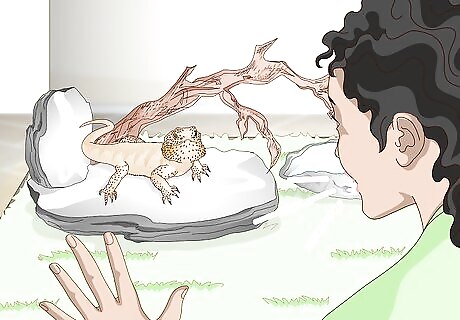
Lower your hand slowly towards the bearded dragon. When your pet is in its cage, you want to use very slow movements to avoid startling it. Try to get the dragon's attention before you slowly put your hand into its habitat to make sure your pet doesn't feel threatened. Check to make sure the bearded dragon is not eating or hunting before you reach for it.
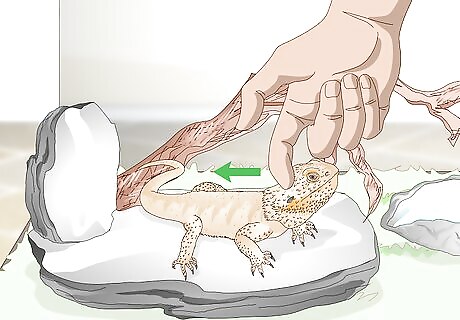
Stroke your pet gently using 1 or 2 fingers. While you can use any of your fingers to pet the bearded dragon, your index finger is the easiest. Start slowly stroking the dragon's head and sides of the face. You can also pet it from head to tail, going slowly and using gentle pressure. Avoid positioning yourself right over the bearded dragon's head as you're petting it—bearded dragons feel threatened by movement above them. If you and your dragon are still getting used to one another, feel free to use food to encourage the interaction. Associating treats with getting handled can help some beardies relax. Never stroke a bearded dragon from the tail to the head.

Pick up the bearded dragon if it appears to be relaxed. If you're petting your bearded dragon and its eyes become droopy, this means it's relaxed and probably wouldn't mind being picked up. Slide your hand under the bearded dragon, carefully scooping it up while making sure to support the weight of its body and tail. Baby beardies are more skittish and can panic when they are picked up. Try to keep the baby calm and keep one finger under its chin while holding it. Never grab or hold a bearded dragon by its legs or tail.

Hold the bearded dragon close to your body. Your pet will feel safer and more secure if they're close to your chest as you're holding them. You can rest their tail on your forearm and use your other hand to gently stroke the dragon, making it happy and content. Continue to keep their body supported by holding them in the palm of your hand.
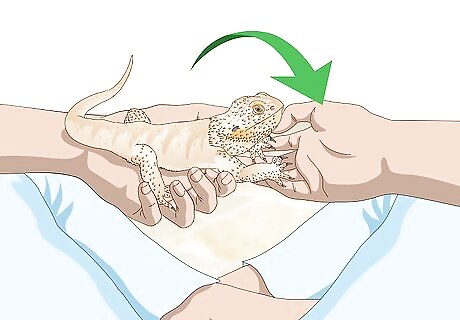
Let the dragon walk from hand to hand as they move. If your dragon is restless and doesn't want to sit calmly in your hand, let it stretch its legs a bit. Support its weight as it walks from your right hand to your left, or your left hand to your right. Keep a close eye on your bearded dragon as it's moving to ensure it doesn't fall.
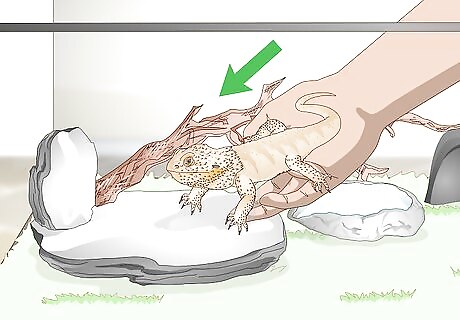
Release the dragon back to its habitat when you're finished petting it. When you are finished petting and bonding with the bearded dragon, slowly move your arm away from your body and lower it into the habitat. Once your hand has touched down, lift up from your elbow to give the dragon a ramp down into its home. After a nice, long handling, you can reward your beardie with a treat.
Recognizing Bearded Dragon Body Language
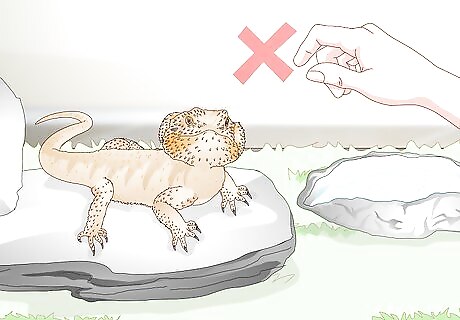
Back off if your bearded dragon fluffs its beard. This is the behavior that gave the bearded dragon its name. When a dragon inflates its beard, it seems larger and more fearsome. It's considered a defensive move and can mean the animal is feeling threatened. Bearded dragons also fluff their beards occasionally when not threatened. Once the two of you know each other better, it will be easier for you to determine when the fluffing is a defensive move and when it isn't.
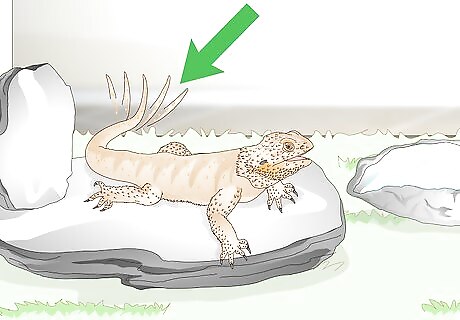
Look for signs of stress like flattening and tail twitching. Beardies’ bodies are already flat, but when they're stressed they can flatten their bodies even more. If your pet is twitching its tail, it could be feeling threatened or agitated.
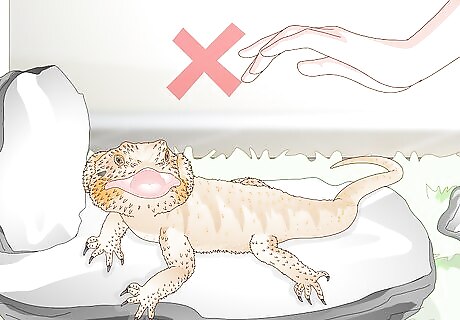
Avoid contact with a bearded dragon that is hissing. This is a very clear-cut signal that you should give the animal its space. Just like you wouldn't want to pet a dog that's growling, it's best to wait until your bearded dragon has stopped hissing to avoid being bitten. If you do get bitten by a bearded dragon, be sure to clean the wound thoroughly with an anti-bacterial soap and apply an antibiotic ointment.
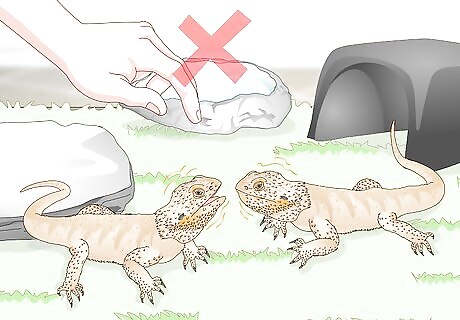
Avoid interrupting two dragons that are bobbing their heads at one another. If you are reaching into a habitat that houses more than one dragon, be on the lookout for a face-off between the animals that includes head bobbing. This is a show of dominance, usually between males, and it means that the animals are not in the mood for a gentle pet or being held. The faster their heads are bobbing, the more aggressive the behavior.
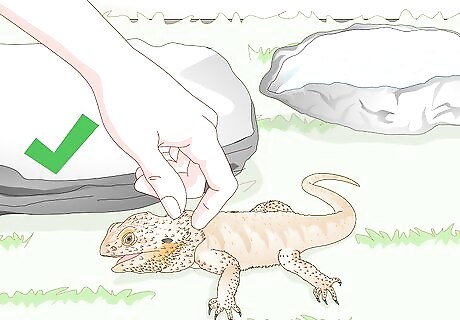
Proceed with caution if you see mouth gaping. While bearded dragons will sometimes leave their mouth open when sunbathing to help adjust to the change in temperature, other times mouth gaping is a sign that they're agitated. Either way, this behavior might be a signal to give your dragon some time before you pet it. As you get to know the animal, you will be able to tell the difference between a stressed state and a relaxed one.
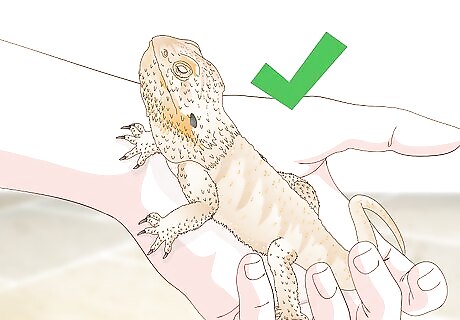
Keep up the contact if your bearded dragon has heavy eyelids. Just like in many other animals, droopy eyelids are a sign that there's a high degree of relaxation and trust. If your dragon is closing its eyes while you pet him, you’re in!
Maintaining Good Hygiene
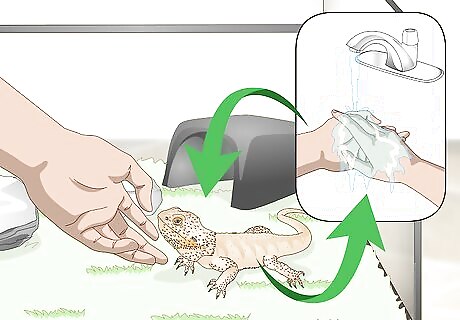
Wash your hands before and after handling a bearded dragon. Reptiles carry a bacteria called Salmonella bongori, which can be passed on to other reptiles. Wash your hands with soap and water before and after petting your dragon to keep your other reptiles and your dragon healthy. Be sure to lather up when washing and scrub all parts of your hands for a full 20 seconds.

Clean scratches or bites thoroughly with anti-bacterial soap. If your bearded dragon bites or scratches you, don't worry, it happens! Clean the cut with anti-bacterial soap and water and apply an ointment to help it heal. Cover the cut with a band-aid to help protect it from dirt and other bacteria. Biting is extremely rare in bearded dragons and scratching will generally only occur if the animal is trying to regain its balance.
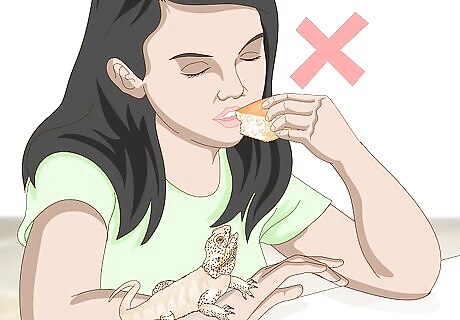
Avoid eating while handling a bearded dragon. Since reptiles such as bearded dragons can spread bacteria, don't eat or prepare food while you're playing with your pet. Save snacking or meal time for after you've finished petting the bearded dragon and have washed your hands thoroughly. Avoid putting your hands near your mouth while handling the bearded dragon, and advise others to do the same if they're playing with your pet as well.













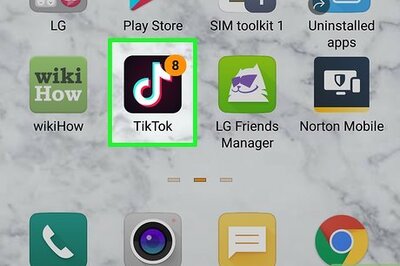





Comments
0 comment